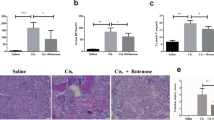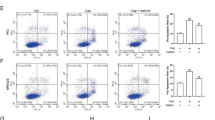Abstract
Background
Cisplatin could result in a wide range of kidney injuries. During the pathogenetic process, the excessive generation of reactive oxygen species (ROS) induced by cisplatin has been regarded as the initial and critical role, by which DNA damage and cell death could subsequently come up. Therefore the elimination of ROS has long been considered as effective mean to prevent cisplatin-induced kidney injury. Myricitrin is a newfound natural polyphenol hydroxy flavonoid glycoside compound, whose forceful anti-oxidative properties had been confirmed. Thus, we aim to investigate if myricitrin could protect against cisplatin-induced kidney injury.
Methods
A cisplatin-induced kidney injury model was established in mice by intraperitoneal injection of cisplatin. The protective effect of myricitrin on kidney injury was evaluated by serum BUN and Cre level. The Kidney pathology was observed with H&E and TUNEL staining. Then cell viability and apoptosis rate were measured using MMT assay and flow cytometry to assess if myricitrin could protect KH-2 cells against cisplatin-induced injury. The intracellular ROS was detected by ROS fluorogenic probe and quantitatively analyzed by flow cytometry. Finally, the expression of Bcl-2 and Bax was investigated by western blotting to indicate the influence in apoptosis pathway.
Results
Myricitrin could significantly remit kidney injury induced by cisplatin and inhibit apoptosis of KH-2 cells. In mechanism, myricitrin could eliminate ROS and subsequently block activation of apoptosis pathway.
Conclusion
Myricitrin protects against cisplatin-induced kidney injury by eliminating excessive ROS.





Similar content being viewed by others
References
Miller RP, Tadagavadi RK, Ramesh G (2010) Mechanisms of cisplatin nephrotoxicity. Toxins (Basel) 2(11):2490–2518
Li CZ, Jin HH, Sun HX, Zhang ZZ, Zheng JX, Li SH, Han SH (2016) Eriodictyol attenuates cisplatin-induced kidney injury by inhibiting oxidative stress and inflammation. Eur J Pharmacol 5(772):124–130
Xu R, Zhang Y, Ye X, Xue S, Shi J, Pan J, Chen Q (2013) Inhibition effects and induction of apoptosis of flavonoids on the prostate cancer cell line PC-3 in vitro. Food Chem 138(1):48–53
Zhang B, Shen Q, Chen Y, Pan R, Kuang S, Liu G, Sun G, Sun X (2017) Myricitrin alleviates oxidative stress-induced inflammation and apoptosis and protects mice against diabetic cardiomyopathy. Sci Rep. 13(7):44239
Wang M, Sun GB, Du YY, Tian Y, Liao P, Liu XS, Ye JX, Sun XB (2017) Myricitrin protects cardiomyocytes from hypoxia/reoxygenation injury: involvement of heat shock protein 90. Front Pharmacol. 8(8):353
Yang Y, Yu X, Zhang Y, Ding G, Zhu C, Huang S, Jia Z, Zhang A (2018) Hypoxia-inducible factor prolyl hydroxylase inhibitor roxadustat (FG-4592) protects against cisplatin-induced acute kidney injury. Clin Sci (Lond). 132(7):825–838
Sastry J, Kellie SJ (2005) Severe neurotoxicity, ototoxicity and nephrotoxicity following high-dose cisplatin and amifostine. Pediatr Hematol Oncol 22(5):441–445
Hengartner MO (2000) The biochemistry of apoptosis. Nature 407(6805):770–776
Pabla N, Dong Z (2008) Cisplatin nephrotoxicity:mechanisms and renoprotective strategies. Kidney Int 73(9):994–1007
Liao HW, Liu EG, Wang DY (2006) Chemical constituents of the bark of Myrica ruba. Cent South Pharm 4:196
Lieberthal W, Triaca V, Levine J (1996) Mechanisms of death induced by cisplatin in proximal tubular epithelial cells: apoptosis vs. necrosis. Am J Physiol 270(4 pt 2):F700–F708
Breckenridge DG, Germain M, Mathai JP et al (2003) Regulation of apoptosis by endoplasmic reticulum pathways. Oncogene 22(53):8608–8618
Kassem ME, Ibrahim LF, Hussein SR, El-Sharawy R, El-Ansari MA, Hassanane MM, Booles HF (2016) Myricitrin and bioactive extract of Albizia amara leaves: DNA protection and modulation of fertility and antioxidant-related genes expression. Pharm Biol. 54(11):2404–2409
Domitrović R, Rashed K, Cvijanović O, Vladimir-Knežević S, Škoda M, Višnić A (2015) Myricitrin exhibits antioxidant, anti-inflammatory and antifibrotic activity in carbon tetrachloride-intoxicated mice. Chem Biol Interact 25(230):21–29
Satoh M, Kashihara N, Fujimoto S, Horike H, Tokura T, Namikoshi T, Sasaki T, Makino H (2003) A novel free radical scavenger, edarabone, protects against cisplatin-induced acute renal damage in vitro and in vivo. J Pharmacol Exp Ther 305(3):1183–1190
Wang F, Liu J, Zhou L, Pan G, Li Z, Zaidi SH, Cheng F (2016) Senescence-specific change in ROS scavenging enzyme activities and regulation of various SOD isozymes to ROS levels in psf mutant rice leaves. Plant Physiol Biochem 109:248–261
Author information
Authors and Affiliations
Contributions
The author contributions were as follows: BZ designed the study; RL drafted the manuscript; The experiments were finished by RL, LH,CH,QW; the data analysis and interpretation involved QW and YL. All authors read and approved the final manuscript.
Corresponding author
Ethics declarations
Ethics approval and consent to participate
All animal experiments conformed to the National Institute of Health Guide for the Care and Use of Laboratory Animals’ (NIH Publication No. 85-23, National Academy Press, Washington, DC, revised 1996), with the approval of the Laboratory Animal Center of Kunming Medical University. The approval ID for this study was 20181092.
Conflict of interest
The authors declare that they have no competing interests.
Additional information
Publisher's Note
Springer Nature remains neutral with regard to jurisdictional claims in published maps and institutional affiliations.
Rights and permissions
About this article
Cite this article
Li, R., Hu, L., Hu, C. et al. Myricitrin protects against cisplatin-induced kidney injury by eliminating excessive reactive oxygen species. Int Urol Nephrol 52, 187–196 (2020). https://doi.org/10.1007/s11255-019-02334-8
Received:
Accepted:
Published:
Issue Date:
DOI: https://doi.org/10.1007/s11255-019-02334-8




